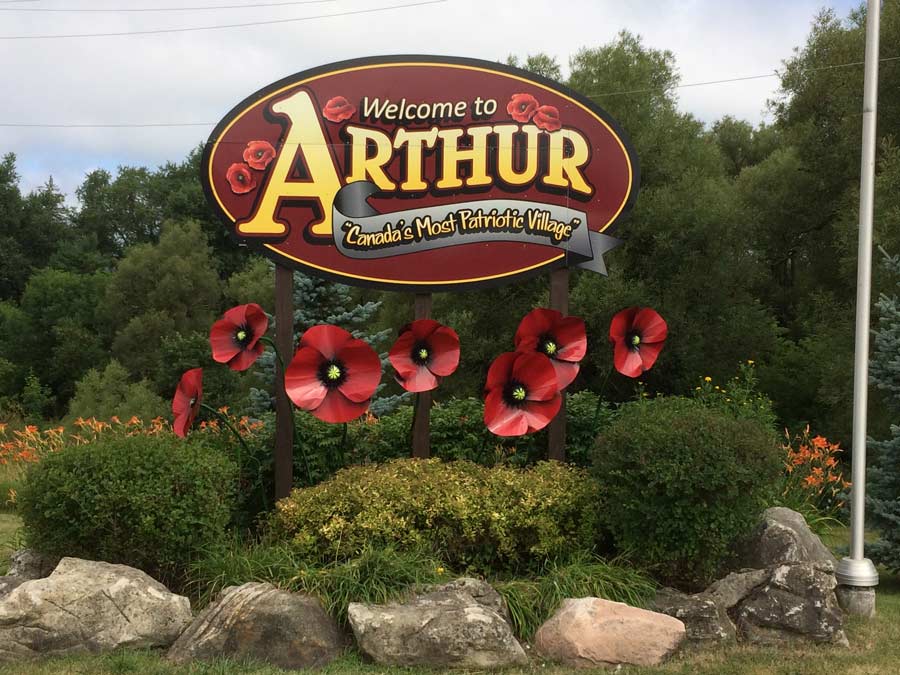WELLINGTON NORTH – Even with a second upgrade to Arthur’s wastewater treatment plant, there may not be enough capacity to handle projected future growth in the village, according to a recent development update provided to council.
A phase one upgrade to Arthur’s wastewater plant, completed at the end of 2020, expanded daily sewage treatment capacity from 1,465 cubic metres to 1,860 cubic metres, or 395 equivalent residential units (ERUs) – a percentage of which are divvied out by council to developers each year for sewage allocation.
The phase one upgrade involved the multi-million-dollar construction of a new equalization tank, preventing a rush of water from significant rain or snowmelt events from overwhelming the plant and pushing under-treated sewage into the Conestogo River.
A February report from development clerk Tammy Pringle states there are 1,210 potential residential units to be built in the village, including those approved by the county (not necessarily the township) to be built and those stemming from initial discussions between the township and developers about potential development.
Pringle’s report echoes a 2020 report calling for attention to the “finite services available for future development” as growth contributes to more wastewater and chips away at more of the plant’s capacity.
Although only a prediction of future development, according to Pringle the potential new residential units are expected to “make use of more than the wastewater treatment plant capacity” and a second upgrade, combined.
Without further capacity opened up at the plant, future development in the village could come to a standstill.
As part of a 2016 Municipal Class Environmental Assessment addressing the limited sewage treatment capacity of Arthur’s plant against projected growth of the village up to 2031, a phase two upgrade was approved by the province with the decision valid until 2024.
The second upgrade would bring the equalization tank in to the treatment process, turning it from a holding tank into an aeration bay and settling tank, bringing the new daily sewage treatment capacity up to 2,300 cubic metres and adding 440 ERUs for new development.
A new headworks building, removing solids from sewage before it enters treatment, would also be installed.
But upgrades are costly feats and remain unfunded. The second phase alone, adjusted for inflation, could cost between $9.1 and $14.9 million according to the 2016 environment assessment.
Arthur is now having to contend with the limited sewage treatment capacity and what to do about it.
Pushing the limits
Considering a predicted residential growth of up to 998 persons in the village come 2031 (based on the county’s 1999 official plan) and how much treated effluent the Conestogo River could handle, the engineering firm completing the environmental assessment at the time, XCG Consulting Ltd., determined the supposed upper limit of what an upgraded plant could handle.
Last year, the township wanted to see if there was potential for the plant to handle more than the maximum of 2,300 cubic metres stated in the environmental assessment.
Responding to the township’s inquiry, Blue Sky Energy Engineering and Consulting Inc. stated the maximum flow the plant could handle was never defined in the XCG assessment, and that doing so would have gone beyond its scope.
03-07-2022 Council Agenda-pages-45-49
“It is therefore possible that this receiver could accommodate a higher design … in the future,” the report states, adding there are “a number of constraints” based on what the Conestogo River could handle.
Seasonal discharge restrictions into the river already apply because of poor river flow and water quality during summer months, when treated effluent is pumped to storage lagoons in the village’s north end.
The Blue Sky report notes those limitations would likely continue to apply should capacity increase beyond a second phase upgrade, creating a need for larger lagoons to handle the increased wastewater treated.
“Very likely what would result in going higher than [2,300 cubic metres] is that the capacity of those storage lagoons would need to be increased,” township operations director Matt Aston told the Advertiser.
“Getting above 2,300 is the only way that Arthur continues to grow.”
But getting to the point of understanding what that entails would be a long and expensive journey, Aston explained.
At least five years of study would be needed for a new environmental assessment costing around $1 million.
Sewage allocations coming to council
Prior to 2019, available ERUs were awarded on a first-come, first-served basis.
Council now takes a more measured approach to control the pace of development and the finite services it has, with policy limiting the amount of units council can commit yearly to 15% of the total reserve.
An engineering firm is currently working out a yearly assessment of how many sewage units the township has available following 2021 hookups. Last year, councillors were able to award 51 ERUs.
Aston expects the reserve calculations this month and said a staff report will go to council shortly thereafter, recommending which developments would be awarded allocations.
The township is requesting all sewage unit applications be submitted before the end of March.




